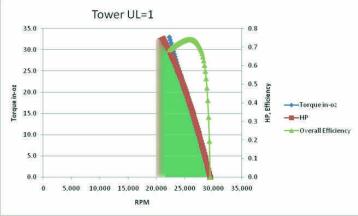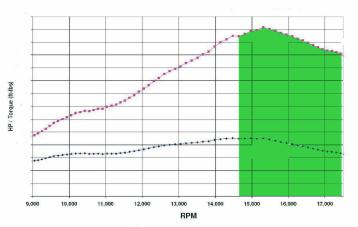


PROPWASH
October 2011
7
For stable operation a power plant needs to operate in an area where the torque rises
as the rpm drops. That way, when increasing propeller load reduces the rpm, the
motor’s torque increases to continue to rotate the propeller. This means you always run
around or beyond the power peak on an internal combustion engine at full throttle. See
the green area on the graph. If the propeller load increases to pull the rpm into an area
of decreasing torque, the rpm will continue to drop until the engine stalls. That doesn’t
take much change in propeller immersion. The torque rise in an internal combustion
engine is much less than in an electric motor. An electric motor’s torque and power
will always increase rapidly with increasing load until something melts or the
controller’s overcurrent protection kicks in.
That means propping an electric boat is very different. It’s immediately obvious
when an internal combustion engine is over propped. The engine sags or stops. It’s not
immediately obvious that an electric motor is trying to pull too big of a prop. The most
direct way to check is to measure the current draw from the motor. The new Castle ICE
controllers have built in data loggers that do this. The Eagle Tree data logger will also
measure current. Indirect methods involve measuring component temperatures and
measuring the input to the battery from the charger after a run. The rated maximum
continuous current for the motor in our example is 100 amps. Fortunately, the motor
Continued on page 8
Another important relationship is
electrical resistance. The current flow is
the voltage divided by resistance.
Increasing resistance reduces the current
and therefore the power. This wasted
power turns up as heat. In watts it is the
current squared times the resistance.
One watt is 3.4 btu’s per hour. A btu
will raise one pound of water one degree
F. That means our 80% efficient power
plant (444 watts of waste heat) generates
25 btu’s per minute. That would raise
the temperature of a pound of uncooled
copper or iron around 250 degrees in a
minute.
But wait a minute. How can an
electric power plant with only 2.4
horsepower drive an outboard tunnel as
fast as a nitro engine? Even a K&B Pro
has 3.5 advertised horsepower.
Remember, the power output from an
electric motor is not related to rpm. To
make this happen, the torque increases
very rapidly as the rpm drops. An
internal combustion engine’s torque is
approximately constant. See the two
graphs below. The first is for a typical P
limited power plant and the second is
for a model gasoline engine.